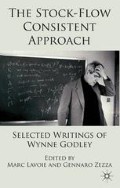Abstract
Throughout my working life I have looked to Sylos Labini for inspiration, presuming to find an affinity with him in major lines of enquiry we have both pursued. I am thinking, most particularly, of his work on a series of related questions concerning the behaviour of firms under conditions of oligopoly, the well-attested practice of mark-up pricing and the meaning (if any) of the aggregate neoclassical production function.
This paper is a revised and condensed version of three lectures called ‘Time, Credit Money and the Neoclassical Synthesis’ Which I gave in Naples in April 1988 at the invitation of Professor Augusto Graziani. It is a summary of a substantial monograph in the course of preparation in collaboration with Ken Coutts. I am grateful for penetrating comments from K. Coutts, A. Graziani, G. Harcourt, S. Mundle, N. Norman and G. Zezza.
Access this chapter
Tax calculation will be finalised at checkout
Purchases are for personal use only
Preview
Unable to display preview. Download preview PDF.
References
Blinder, A.S. and R. Solow (1973) ‘Analytical Foundations of Fiscal Policy.’ In A.S. Blinder, R. Solow et al.(eds),The Economics of Public Finance (Washington: Brookings Institution).
Christ, C.F. (1967) ‘A Short-Run Aggregate Demand Model of the Interdependence of Monetary and Fiscal Policies with Keynesian and Classical Interest Elasticities.’ American Economic Review, May.
Clower, R.W. (1985) ‘The Keynesian Cross Revisited.’ Working Paper, 383, Department of Economics, University of California.
Dornbusch, R. and S. Fischer (1984) Macroeconomics, 3rd edition (Tokyo: McGraw-Hill).
Fischer, S. (1987)‘1944, 1963 and 1985.’ In R. Dornbusch, S. Fischer, J. Bossons (eds), Macroeconomics and Finance (Cambridge, Mass.: MIT Press).
Friedman, M. (1968) ‘The Role of Monetary Policy.’ American Economic Review 78 (March).
Godley, W. and F. Cripps (1983) Macroeconomics (London: Fontana).
Graziani, A. (1989) ‘The Theory of the Monetary Circuit.’ Thames Paper, 12.
Hicks, J. (1937) ‘Mr Keynes and the “Classics”: A Suggested Interpretation.’ Econometrica 5.
Hicks, J. (1980–1981) ‘IS-LM: An Explanation.’ Journal of Post Keynesian Economics 3 (January).
Hicks, J. (1989) A Market Theory of Money (Oxford: Basil Blackwell).
Kahn, R. (1931) ‘The Relation of Income Investment to Unemployment.’ Economic Journal 41 (June): 173–198, reprinted in Selected Essays on Unemployment and Growth (Cambridge: Cambridge University Press, 1972), pp. 1–27.
Kaldor, N. (1939) ‘Speculation and Income Stability.’ Review of Economic Studies 7: 1–27, reprinted in Essays on Economic Stability and Growth, Vol. II (London: Duckworth, 1960).
Kaldor, N. (1980) ‘The Foundations of Free Trade Theory and Their Implications for the Current World Recession.’ In E. Malinvaud and J.-P. Fitoussi (eds), Unemployment in Western Countries (London: Macmillan), pp. 85–100.
Leijonhufvud, A. (1983) ‘What Was the Matter with IS–LM?’ In Fitoussi J.-P. (ed.), Modern Macroeconomic Theory (Oxford: Basil Blackwell).
Lucas, R.E. (1973) ‘Some International Evidence on Output-Inflation Tradeoffs.’ American Economic Review 63 (June).
Malinvaud, E. (1977) The Theory of Unemployment Reconsidered (Oxford: Basil Blackwell).
Modigliani, F. (1944) ‘Liquidity Preference and the Theory of Interest and Money.’ Econometrica 12.
Modigliani, F. (1963) ‘The Monetary Mechanism and Its Interaction with Real Phenomena.’ Review of Economics and Statistics 45.
Pasinetti, L.L. (1974) Growth and Income Distribution (Cambridge: Cambridge University Press).
Patterson, D.M. (1988) ‘Stock-Flow Consistent Accounting: A Macroeconomic Perspective.’ Economic Journal 98 (September).
Sargent, Th. (1987) Macroeconomic Theory (San Diego: Academic Press).
Sylos Labini, P. (1988) ‘The Great Debates on the Laws of Return and the Value of Capital: when Will Economists Finally Accept Their Own Logic?’ BNL Quarterly Review 166 (September).
Tobin, J. (1980) ‘Money and Finance in the Macroeconomic Process.’ Journal of Money, Credit and Banking 14.
Tobin and W. Buiter (1976)‘The Long Run Effects of Fiscal and Monetary Policy on Aggregate Demand.’ In J.L. Stein (ed.) Monetarism (Amsterdam: North-Holland Press).
Wood (1979) A Theory of Profits (Cambridge: Cambridge University Press).
Editor information
Editors and Affiliations
Copyright information
© 2012 Wynne Godley
About this chapter
Cite this chapter
Godley, W. (2012). Time, Increasing Returns and Institutions in Macroeconomics. In: Lavoie, M., Zezza, G. (eds) The Stock-Flow Consistent Approach. Palgrave Macmillan, London. https://doi.org/10.1057/9780230353848_3
Download citation
DOI: https://doi.org/10.1057/9780230353848_3
Publisher Name: Palgrave Macmillan, London
Print ISBN: 978-1-349-33275-5
Online ISBN: 978-0-230-35384-8
eBook Packages: Palgrave Economics & Finance CollectionEconomics and Finance (R0)

